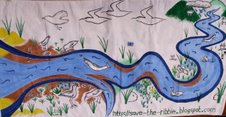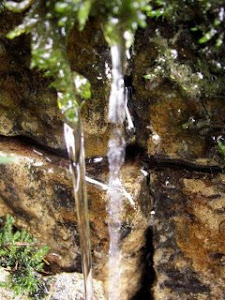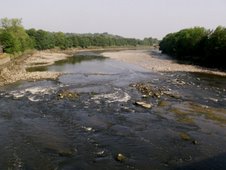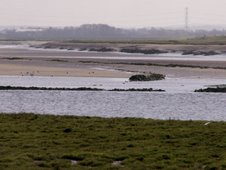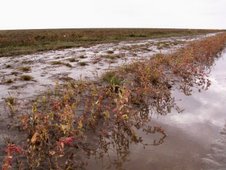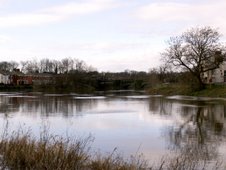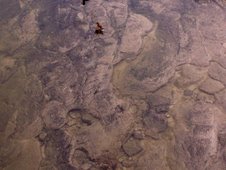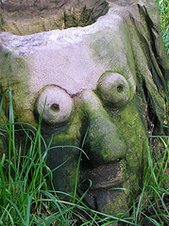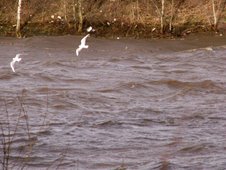
Out over the Estuary at Marshside near Southport in cold Winter sunshine, the Ribble's Wetland habitat is one of the last great wildernesses in Britain - and home to huge numbers of bird species on an Internationally significant scale.
The Ribble currently supports at least as many bird species - if not more - than both Morecambe Bay and the Wash, despite the enormous difference in size.
And it's all because of this stuff...

Mud, mud, glorious mud... full of nutrients which feed the enormous numbers of invertebrates which live in it - and therefore feeding the bird species which live on the Ribble all year round - as well as providing protected nursery sites for fish fry before these are big enough to cope with the open seas.
Because the Ribble's saltmarsh and mudflats are natural and effective absorbers and diffusers of the sea's tidal energy, these areas also protect the surrounding inland areas from flooding.
The Ribble's rich intertidal habitat is a delicate and unique balance created by the inter-relationship between the organic sediments (clay and organic matter) washed down the Ribble (and down the Darwen into the Ribble) and the sandy sediments washed in from the Irish Sea, mixed together by the swirling mixture of saline tides and fresh river water before being deposited across the whole Estuary - as well as on those mudflats in the tidal areas of the River which are also subject to the sea's tidal influence.
The resultant mudflats and saltmarsh have a strong mineral base which is very rich indeed in terms of nutrients - which is why it supports such a huge range of invertebrates that their numbers are practically incalculable...
Sand Hoppers alone are resident in the Ribble's mud in the region of anything between 50,000 to 400,000 per square metre... then you have various species of Snails, Lug Worms, Cockles, and zillions of other invertebrate and shell fish species, all happily living together in the Ribble's rich mud - and incidently feeding hundreds of thousands of birds!
That's why the Ribble's intertidal mudflats and saltmarsh have more energy per square metre than Rainforest...
... and these intertidal habitats are also more rare than Rainforest.

Thousands of Pink-Footed Geese fly in to the Ribble at Marshside and nearby Martin Mere from Iceland for the winter months. Listening to their excitement when they arrive is absolutely fantastic and well-worth a trip to experience.
They will be getting ready to fly back to their Northen breeding grounds soon and the RSPB are having special walks out to see them on March 4th, although you can take a trip to Marshside at any time, all year round, to see a wealth of the Ribble's bird species.

Ribble Saltmarsh - an endangered habitat, rarer than rainforest, essential wetland habitat for birds, fish, invertebrates, and rare plants... and also essential and effective flood defences for the Ribble's human communities.
Saltmarsh is also a vital habitat for a number of our countryside birds, many of which are in national decline, including Skylarks who breed on the saltmarsh during the Neap tides aroung the Summer Solstice and eat the saltmarsh seeds - and Marshside is the best place in Lancashire for these thrilling birds.
Merlin, Peregrines, Barn Owls, Hen Harriers, and Natterjack Toads also inhabit the Ribble's intertidal areas.

Hundreds of Shelduck on the Ribble saltmarsh at Marshside, just one of the many bird species who over-winter on the Ribble. The Ribble supports over 1/4 million birds every winter, which is why it is the most important Estuary River in Britain, if not Europe. Many of the Ribble's bird and fish species are also declining in numbers, or are rare and even endangered species on a global scale, including birds such as Redshank, Pintail, Mediterranean Gull, and Black-Tailed Godwit, and fish species such as Atlantic Salmon (the 10th most threatened animal species in europe) and Sea Trout.
The overwintering bird species account for roughly half of the total number of birds who live on the Ribble all year round - so approximately as many as half a million birds are feeding, breeding, raising their young, moulting, and generally having a wild life on the Ribble every year.

Lapwing, Black-Tailed Godwit and Greenshank just some of the enormous numbers of wading birds and wildfowl to be seen at RSPB Marshside.

Low tide reveals an old causeway out on the Estuary at Marshside: always check at the RSPB Reserve Hide for the times of the tides before you walk out this far as the incoming tide is very fast and can be deadly.
The beauty and importance of the Ribble's Wet Wonderland extends throughout its 75 miles. Whilst it is the Estuary which is a Special Protection Area under the Conservation (Habitats &c) Regs 1994, the EU Birds Directive, and the International RAMSAR Convention - as well as being a SSSI, Biological Heritage Site, and National Nature Reserve - the River is, of course, an ecosystem, and is therefore also recognised as a Biological Heritage Site throughout its length, even before it opens out into the Estuary.
The point where the Ribble opens out into the Estuary is where the Ribble leaves the last point of its narrower River channel as it runs down between Preston on the north bank and Penwortham, South Ribble, on the south bank.
Yet this part of the river is still part of the Ribble's intertidal habitat as the tide progresses 11 miles inland from the sea. As such, this part of the Ribble is as subject to the dramatic changes of the tides and seasons as the Estuary itself, and also has its fair share of over-wintering Wading birds and other wildfowl, feeding on the tidal mudflats which extend as far inland as the Old Tram Bridge which runs between Avenham Park in Preston and Penwortham.
This is why the Ribble Shoreline Management Plan now extends as far inland as Old Penwortham Bridge, which connects Broadgate in Preston to Middleforth in Penwortham, this point - the Middle Forth - an ancient ford across shallow waters at low tide before the bridge was built here in the 1700s.

Old Penwortham Bridge at low tide...

Low tide from Old Penwortham Bridge on a cold but sunny winter afternoon: some of the best mudflats in these largely urban areas are to be found here on the Broadgate side, as well as on the Penwortham side from Priory Park below St. Mary's Church and Penwortham Castle and Motte, stretching upriver as far as the Old Tram Bridge at the furthest end of Avenham Park.
These flats change with each tide: thick mud one day, sandy shores the next, or washed down to shingle beaches by spate waters the next... yet regardless of what the tides and river waters bring, they are inevitably busy with any numbers of birds such as Black-Headed Gulls, Mallard, Cormorants, Redshank, Teal, and even the local Crows and Magpies will pop down for a snack at low tide.

Footprints in the mudflats - a thin skim of mud over a sandy shore on this occasion...

Ribble silts clearly visible washing downriver at low tide, replenishing the Ribble's vital mudflats and saltmarsh habitats every day twice a day, as they have done for many thousands of years...
The Ribble's tidal nature also means it is an endlessly changing and beautiful landscape for its human communities...

Old Penwortham Bridge, a misty winter morning in January on a gently retreating tide.

A clear winter afternoon, high tide coming in...

From Old Penwortham Bridge during rains...

... and gentle currents on a late winter afternoon...

...the same spot as the tide goes out, the Ribble waters rushing over the ancient rock forms of the river bed...

Prehistoric Ribble riverbed at very low tide from on Old Penwortham Bridge...
A close view of the beautiful patterns in the fossilised mud upon which Old Penwortham Bridge was built in 1759 - the second attempt at a permanent river crossing here at Middleforth as the first bridge, which was built in 1752, collapsed into the Ribble shortly after it was built only seconds after the local vicar had crossed it, so the story goes...
before a bridge was built here, local people could only cross at low tide, although there was still a ferryboat just a few metres upriver until the last century.

Old Penwortham Bridge on a clear winter's day...

...and during rains...

Spate waters through Penwortham and Preston...

A winter dusk, calm waters...
There's the view, and then there's the wildlife...!

Redshank in Broadgate: now is an excellent time to look out for these shy birds.
Take a walk along the Ribble in Penwortham and Broadgate, particularly the stretch between the Penwortham flyover and the Tram Bridge and you are practically guaranteed to spot these birds over the winter months. This one was amongst a significant number who can be seen almost daily in Broadgate and Middleforth around the Old Penwortham Bridge.
Redshank merge in very well with the mudflats and shingles banks though so look very carefully and don't let them see you - although hearing their echoing cry as they fly away is almost worth their taking flight!

Birdwatching on the way across Old Penwortham Bridge from Penwortham to Preston. The new Victorian-style "gas" lamps look very elegant...

Redshank from that very spot...

Black-Headed Gulls at low tide enjoying the winter sunshine and forming beautiful patterns as they follow the contours of the riverbed mud between Broadgate and Penwortham. The ferryboat used to run just upriver (right) from this point.

Frosty morning in Penwortham...

A chill, damp and misty day by the Ribble has its own beauty, and still draws many Ribblesiders out of doors to enjoy the peace and tranquillity of the River and Green Belt areas.

Resident Goose on the Ribble at the stretch between Broadgate and Penwortham: there was a whole family until last Winter, 2005-6, when the three adults disappeared overnight, leaving this luckily old-enough to survive youngster on her own.

Ribble riverbanks in Winter provide much needed protection from the elements, and abundant food in the mud...
Marshgrasses and mudflats for our resident River birds and our Winter visitors from Iceland, Northern and Eastern Europe, Russia, and even the Arctic circle. Many of these species are also in decline, both nationally and internationally - some very seriously - due to habitat loss...
A Ribble Winter landscape, from Penwortham towards Broadgate at the mudflats next to the Railway bridge crossing to and from Preston Station.

The Penwortham mudflats are a vital resource for resident and over-wintering birds alike - and even many Mallard also fly here for from their breeding grounds in Northern Europe and Russia to join our resident species for the Winter months.

Goosander and Mallard... from the ordinary...

to the unusual...

Great Crested Grebe on the incoming tide between Broadgate and Penwortham...

Female Goosander at low tide, Walton le Dale...

Mallard at the still waters of high tide...

Winter food and habitats provide essential living-space for hedgerow and farmland birds who live on the Ribble's Green Belt areas. Many of these birds are resident all year round, and many are migratory species who travel for thousands of miles from Southern Europe, Scandanavia, and Africa (including crossing the Sahara Desert) to breed here in the Summer months.
Many British hedgerow and farmland birds have declined by approximately 50% in recent decades - but some species, such as Tree Sparrows, by over 80%. We need to protect their habitats as a matter of urgency.

A fabulous willow inhabits the Ribble's banks near Priory Park in Penwortham.

Male Great Tit chirping away - many birds think it's Spring already with the unseasonably warm weather. We have seen a Black-Headed Gull who already has his distinctive black cap breeding plumage amongst the still black eye-browed winter plumage of his fellows; a pair of Magpies and Great Tits building nests; Dunnock flashing their wings at one another; and two Swans courting in Broadgate, with wings beautifully curved and arched love-heart necks.

Greenfinch amongst the many farmland and hedgerow species who inhabit the Penwortham Green Belt opposite Avenham and Miller Parks. This is a wonderful area to explore all year round, full of a diverse range of wildlife habitats from riverbanks and scrubland, to meadows, woodlands, grasslands, streams and ponds.
We must preserve these vital wildlife habitats for now and for future generations.
You can contact Reigh Belisama at savetheribble@tiscali.co.uk












